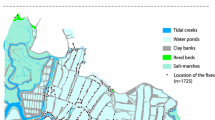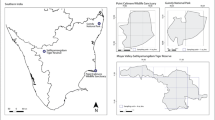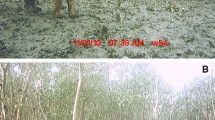Abstract
The threat of invasive species is often intensified in disturbed habitat. To optimize control programs, it is necessary to understand how degraded habitat influences the behavior of invasive species. We conducted a radio telemetry study to characterize movement and habitat use of introduced male Argentine black and white tegus (Tupinambis merianae) in the Everglades of southern Florida from May to August 2012 at the core and periphery of the introduced range. Tegus at the periphery moved farther per day (mean 131.7 ± 11.6 m, n = 6) compared to tegus at the core (mean 50.3 ± 12.4 m, n = 6). However, activity ranges were not significantly smaller in the core (mean 19.4 ± 8.4 ha, n = 6) compared to periphery (mean 29.1 ± 5.2 ha, n = 6). Peripheral activity ranges were more linear due to activity being largely restricted to levee habitat surrounded by open water or marsh. Tegus were located in shrub or tree habitat (mean 96 %) more often than expected based on random locations (mean 58 %), and the percent cover of trees and shrubs was higher in activity ranges (mean 61 %) than the general study area (17 %). Our study highlighted the ability of tegus to spread across the Florida landscape, especially in linear disturbed habitats where increased movement occurred and in areas of altered hydrology where movement is not restricted by water.




Similar content being viewed by others
References
Abe AS (1983) Observation on dormancy in tegu lizards—Tupinambis teguixin (Reptilia, Teiidae). Naturalia 8:135–139
Aebischer NJ, Robertson PA, Kenward RE (1993) Compositional analysis of habitat use from animal radio-tracking data. Ecology 74:1313–1325
Alford RA, Brown GP, Schwarzkopf L, Phillips BL, Shine R (2009) Comparisons through time and space suggest rapid evolution of dispersal behavior in an invasive species. Wildl Res 36:23–28
American Veterinary Medical Association (2013) AVMA guidelines for the euthanasia of animals, 2013th edn. American Veterinary Medical Association, Schaumburg
Brooks WR, Jordan RC (2010) Enhanced interspecific territoriality and the invasion success of the spotted tilapia (Tilapia mariae) in South Florida. Biol Invasions 12:865–874
Brown GP, Phillips BL, Webb JK, Shine R (2006) Toad on the road: use of roads as dispersal corridors by cane toads (Bufo marinus) at an invasion front in tropical Australia. Biol Conserv 133:88–94
Cardozo G, Naretto S, Zak M, Chiaraviglio M (2012) The role of landscape in contact zones of sister species of lizards. In: Tiefenbacher J (ed) Perspectives on nature consevation—patterns, Pressures and Prospects. James and Marilyn Lovell Center for Environmental Geography and Hazards Research, Department of Geography Texas State University, San Marcos, pp 161–176
Castro ER, Galetti M (2004) Frugivoria e dispersão de sementes pelo lagarto teiú Tupinambis merianae (Reptilia: Teiidae). Papéis Avulsos de Zoologia, São Paulo 44:91–97
Center TD, Purcell MF, Pratt PD, Rayamajhi MB, Tipping PW, Wright SA, Dray FA Jr (2012) Biological control of Melaleuca quinquenervia: an Everglades invader. Biocontrol 57:151–165
Chamut S, Jahn GA, Arce OEA, Manes ME (2012) Testosterone and reproductive activity in the male tegu lizard, Tupinambis merianae. Herpetol Conserv Biol 7(3):299–305
Dorcas ME, Willson JD (2011) Invasive pythons in the United States: ecology of an introduced predator. Univeristy of Georgia Press, Athens
Duever MJ, Meeder JF, Meeder LC, McCollom JM (1994) The climate of south Florida and its role in shaping the Everglades ecosystem. Everglades: the ecosystem and Its restoration. St. Lucie Press, Delray Beach, pp 225–248
Embert D, Fitzgerald L, Waldez F (2010) Salvator merianae. IUCN 2013. IUCN Red List of Threatened Species. Version 2013.2. www.iucnredlist.org. Accessed on 17 Dec 2013
Escalona T, Fa JE (1998) Survival of nests of the terecay turtle (Podocnemis unifilis) in the Nichare-Tawadu Rivers, Venezuela. J Zool 244:303–312
Ewel JJ (1986) Invasibility: lessons from south Florida. In: Mooney HA, Drake J (eds) Ecology of biological invasions of North America and Hawaii. Springer, New York, pp 214–230
Fitzgerald LA, Chani JM, Donadío OE (1991) Tupinambis lizards in Argentina: implementing management of a traditionally exploited resource. In: Robinson J, Redford K (eds) Neotropical wildlife: use and conservations. University of Chicago Press, Chicago, pp 303–316
Florance D, Webb JK, Dempster T, Kearney MR, Worthing A, Letnic M (2011) Excluding access to invasion hubs can contain the spread of an invasive vertebrate. Proc R Soc B Biol 278:2900–2908
Galetti M, Bovendorp RS, Fadini RF, Gussoni COA, Rodrigues M, Alvarez AD, Guimarães PR, Alves K (2009) Hyper abundant mesopredators and bird extinction in an Atlantic forest island. Zoologia (Curitiba) 26:288–298
Gelbard JL, Belnap J (2003) Roads as conduits for exotic plant invasions in a semiarid landscape. Conserv Biol 17:420–432
Hobbs RJ (2000) Land-use Changes and Invasions. In: Mooney HA, Hobbs RJ (eds) Invasive species in a changing world. Island Press, Washington, pp 55–64
Jules ES, Kauffman MJ, Ritts WD, Carroll AL (2002) Spread of an invasive pathogen over a variable landscape: a nonnative root rot on Port Orford cedar. Ecology 83:3167–3181
Kiefer MC, Sazima I (2002) Diet of juvenile tegu lizard Tupinambis merianae (Teiidae) in southeastern Brazil. Amphib-Reptil 23:105–108
Knickerbocker CM, Leitholf S, Stephens EL, Keellings DJ, Laird H, Anderson CJR, Fauth JE, Quintana-Ascencio PF (2009) Tree encroachment of a sawgrass (Cladium jamaicense) marsh within an increasingly urbanized ecosystem. Nat Area J 29:15–26
Krysko KL (2002) Seasonal activity of the Florida kingsnake Lampropeltis getula floridana (Serpentes: Colubridae) in southern Florida. Am Midl Nat 148:102–114
Krysko KL, Burgess JP, Rochford MR, Gillette CR, Cueva D, Enge KM, Somma LA, Stabile JL, Smith DC, Wasilewski JA, Kieckhefer GN III, Granatosky MC, Nielsen SV (2011) Verified non-indigenous amphibians and reptiles in Florida from 1863 through 2010: outlining the invasion process and identifying invasion pathways and stages. Zootaxa 3028:1–64
Lanfri S, Di Cola V, Naretto S, Chiaraviglio M, Cardozo G (2013) Understanding the ecological niche to elucidate spatial strategie of the southernmost Tupinambis lizards. Amphib-reptil 34:551–565
Lodge TE (2010) The Everglades handbook: understanding the ecosystem, 3rd edn. CRC Press, Boca Raton, pp 279–333
Martuscelli P, Olmos F (1996) Tupinambis teguixin (common tegu): foraging. Herpetol Rev 27:1–21
Marvier M, Kareiva P, Neubert MG (2004) Habitat destruction, fragmentation, and disturbance promote invasion by habitat generalists in a multispecies metapopulation. Risk Anal 24:869–878
Mazzotti FJ, McEachern MA, Rochford MR, Reed RN, Eckles J, Vinci JJ, Edwards J, Wasilewski JA (2014) Invasive tegu lizards as nest predators of crocodilians and turtles in Florida, USA. Biol Invasions doi doi.org/10.1007/s10530-014-0730-1
Mercolli C, Yanosky A (1994) The diet of adult Tupinambis teguixin (Sauria: Teiidae) in the eastern chaco of Argentina. Herpetol J 4:15–19
Meshaka WE Jr (2011) A runaway train in the making: the exotic amphibians, reptiles, turtles, and crocodilians of Florida. Monograph 1. Herpetol Conserv Biol 6:1–101
Mieres MM, Fitzgerald LA (2006) Monitoring and managing the harvest of tegu lizards in Paraguay. J Wildl Manage 70:1723–1734
Milstead WW (1961) Notes on teiid lizards in southern Brazil. Copeia 1961:493–495
Montaño RR, Cuéllar RL, Fitzgerald LA, Mendoza F, Soria F, Fiorello CV, Deem SL, Noss AJ (2013) Activity and ranging behavior of the red tegu lizard Tupinambis rufescens in the Bolivian Chaco. South Am J Herpetol 8:81–88
Mooney HA, Cleland EE (2001) The evolutionary impact of invasive species. Proc Nat Acad Sci 98:5446–5451
Noriega T, Ibañez MA, Bru E, Manes ME (2002) The testicualr cycle of captive Tupinambis merianae lizards in a temperate environment. Cuad Herpetol 16:119–127
Péres Jr AK (2003) Sistemática e Conservação de Lagartos do Gênero Tupinambis (Squamata, Teiidae). D.Sc. Thesis. Brasília: Universidade de Brasília, Programa de pós-graduação em Biologia Animal, p. 193
Pejchar L, Mooney HA (2009) Invasive species, ecosystem services and human well-being. Trends Ecol Evol 24:497–504
Pernas T, Giardina DJ, McKinley A, Parns A, Mazzotti FJ (2012) Field observations of nesting by the Argentine black and white tegu, Tupinambis merianae, in south Florida. Southeast Nat 11:765–770
Pimentel D, Zuniga R, Morrison D (2005) Update on the environmental and economic costs associated with alien-invasive species in the United States. Ecol Econ 52:273–288
Polis GA, Strong DR (1996) Food web complexity and community dynamics. Am Nat 147:813–846
Presch W (1973) A review of the tegus, lizard genus Tupinambis (Sauria: Teiidae) from South America. Copeia 4:740–746
R Development Core Team (2009) R: a language and environment for statistical computing. R Foundation for Statistical Computing, Vienna
Rodda GH, Dean-Bradley K, Savidge JA, Christy MT, Tyrrell CL (2008) Post-colonization reversal of selection pressure on dispersal behavior of the Brown Treesnake, Boiga irregularis, on Guam. South Am J Herpetol 3:123–134
Sazima I, D’Angelo GB (2013) Range of animal food types recorded for the tegu lizard (Salvator merianae) at an urban park in South-eastern Brazil. Herpetol Notes 6:427–430
Smith KG (2006) Patterns of nonindigenous herpetofaunal richness and biotic homogenization among Florida counties. Biol Conserv 127:327–335
Stevens AJ, Stevens NM, Darby PC, Percival HF (1999) Observations of fire ants (Solenopsis invicta Buren) attacking apple snails (Pomacea paludosa Say) exposed during dry down conditions. J Molluscan Stud 65:507–510
Urban MC, Phillips BL, Skelly DK, Shine R (2008) A toad more traveled: the heterogeneous invasion dynamics of cane toads in Australia. Am Nat 171:E134–E148
Vitousek PM, Mooney HA, Lubchenco J, Melillo JM (1997) Human domination of Earth’s ecosystems. Science 277:494–499
Wilcove DS, Rothstein D, Dubow J, Phillips A, Losos E (1998) Quantifying threats to imperiled species in the United States: assessing the relative importance of habitat destruction, alien species, pollution, overexploitation, and disease. Bioscience 48:607–615
Winck GR, Cechin SZ (2008) Hibernation and emergence pattern of Tupinambis merianae (Squamata: Teiidae) in the Taim Ecological Station, southern Brazil. J Nat Hist 42:239–247
Winck GR, Blanco CC, Cechin SZ (2011) Population ecology of Tupinambis merianae (Squamata, Teiidae): home-range, activity and space use. Anim Biol 61:493–510
With KA (2002) The landscape ecology of invasive spread. Conserv Biol 16:1192–1203
Acknowledgments
Funding was provided by the U.S. Fish and Wildlife Service, USGS Invasive Species Program, USGS Greater Everglades Priority Ecosystem Science Program, and the U.S. National Park Service. We thank the staff of the Everglades National Park for their support. We thank R. Rozar, E. Metzger, M. Curtis, J. Duquesnel, S. Goetz, S. Farris, S. Williams, M. Squires, D. Smith, B. Smith, S. McKinley, T. Pernas, J. Edwards, E. Larrivee, M. Serota, R. Bijlani, V. Briggs, C. Speroterra, P. Campbell, and E. Lavergne for assistance. L. Bonewell provided project management. We thank M. Hayes and L. Fitzgerald for providing comments on an earlier version of the manuscript. Research was approved by the USGS Fort Collins Science Center Institutional Animal Care and Use (IACUC) committee. Research permits were provided by Florida Fish and Wildlife Commission and South Florida Water Management District. Any use of trade, product, or firm names is for descriptive purposes only and does not imply endorsement by the U.S. Government.
Author information
Authors and Affiliations
Corresponding author
Additional information
Katelin K. Craven has been contracted to U.S. Geological Survey Fort Collins Science Center.
Rights and permissions
About this article
Cite this article
Klug, P.E., Reed, R.N., Mazzotti, F.J. et al. The influence of disturbed habitat on the spatial ecology of Argentine black and white tegu (Tupinambis merianae), a recent invader in the Everglades ecosystem (Florida, USA). Biol Invasions 17, 1785–1797 (2015). https://doi.org/10.1007/s10530-014-0834-7
Received:
Accepted:
Published:
Issue Date:
DOI: https://doi.org/10.1007/s10530-014-0834-7




